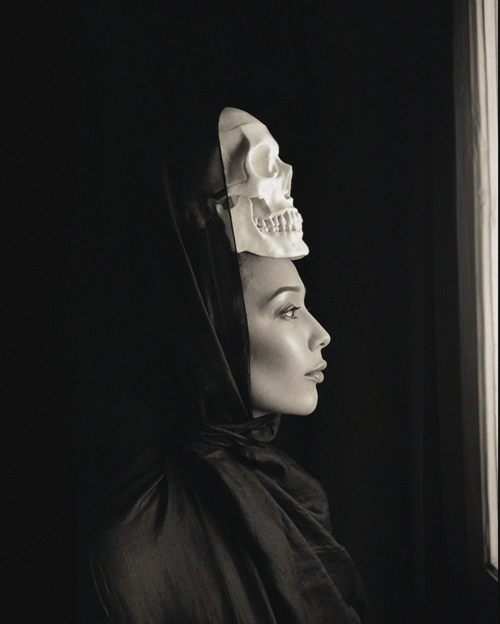La
porteuse
de mémoire
حاملة
الذاكرة
Photographies performatives
impression sur Hahnemühle Baryta 325g, contrecollée sur Dibond 2 mm
54,38 x 67,87 cm chacune
2025
Cette série est née d’une rencontre fortuite. Zohra Hassani avait commandé un crâne anatomique en résine – reproduction fidèle utilisée pour les études médicales – dans le cadre d’un projet de sculpture. Lorsqu’elle le reçoit, la qualité troublante de l’objet la frappe : ses proportions humaines, son réalisme. Devant un miroir, elle compare instinctivement sa propre tête à celle du crâne. Dans ce reflet – l’ossature nue côtoie le vivant – quelque chose se révèle : le temps lui-même devient visible, palpable. Le passé et le présent occupent le même espace.
Le geste s’impose alors naturellement : porter le crâne sur sa tête, créer une verticalité qui unifie vie et mort en une seule silhouette. Le voile noir, en enveloppant à la fois son visage et l’objet, fusionne les deux têtes en une seule forme. Ce qui aurait pu être macabre devient apaisant. *Présence* et *Écho* ne cultivent pas la peur de la mort ; elles proposent une autre relation à elle, fondée sur la continuité plutôt que la rupture.
Pour l’artiste, cette image fonctionne comme un autoportrait étendu. Zohra Hassani porte le prénom de sa grand-mère paternelle et de sa grand-mère maternelle, décédée jeune. Dans sa famille, ce nom est chargé d’une responsabilité symbolique : incarner la mémoire de celle qui n’est plus. Cette transmission ne se limite pas au nom. L’artiste décrit une expérience corporelle singulière de la mémoire héréditaire – une sensibilité aux présences ancestrales qui traverse son corps, ses mains, sa pratique. Dans certaines cultures maghrébines, cette forme de transmission est reconnue et nommée ; dans le contexte occidental, elle demeure souvent indicible.
Présence et Écho rendent visible cette condition : être un corps-archive, littéralement porteuse des mémoires de celles qui l’ont précédée. La première photographie, yeux ouverts, ancre l’artiste dans le présent, tournée vers le monde extérieur. La seconde, yeux fermés, la montre à l’écoute de son intériorité, en dialogue avec ces voix silencieuses qui l’habitent.
Le choix du noir et blanc n’est pas anodin. Il inscrit ces images dans une temporalité trouble, entre passé présent et futur. Il évoque aussi le clair-obscur des maîtres anciens, cette lumière qui sculpte le visage et lui confère une dignité monumentale. Car il est aussi question de dignité ici : celle des femmes maghrébines, de leurs corps souvent réduits à des symboles dans les discours occidentaux. Le voile, dans ce travail, est à la fois un vêtement quotidien, un marqueur de protection et un élément formel qui structure l’image.
Ces photographies ne cherchent pas à être décryptées. Elles ne cachent rien, ne jouent pas sur l’ambiguïté conceptuelle. Elles sont ce qu’elles montrent : une artiste qui se tient debout, en paix avec ses morts, consciente que la vie et la mort ne sont pas opposées mais entrelacées.


صور أدائية
طباعة على ورق هاهنِه مولِه بارِيتا 325 غ، مُثبَّتة على ديبوند 2 مم
54.38 × 67.87 سم لكل واحدة
2025
وُلدت هذه السلسلة من صدفة. فقد طلبت زهرة حسّاني جمجمة تشريحية من الراتينج — نسخة دقيقة تُستخدم في الدراسات الطبية — ضمن إطار مشروع للنحت. وعندما وصلتها، صدمتها واقعية الجسم: أبعاده البشرية، تشابهه المقلق مع الحقيقي. أمام المرآة، قارنت غريزياً بين رأسها ورأس الجمجمة. في هذا الانعكاس — عظم عارٍ بجوار كائن حي — انكشف شيء ما: أصبح الزمن مرئياً، ملموساً. الماضي والحاضر يحتلان الفضاء نفسه.
ثم فرضت الحركة نفسها بشكل طبيعي: حمل الجمجمة فوق رأسها، خلق عمودية تُوحِّد الحياة والموت في هيئة واحدة. يغلف الحجاب الأسود وجهها والجمجمة معاً، فيُدمج الرأسين في شكل واحد. ما كان يمكن أن يكون مشهداً جنائزياً يصبح مُهدِّئاً. لا تسعى حضور وصدى إلى إثارة الخوف من الموت؛ بل تقدّمان علاقة أخرى معه، علاقة تستند إلى الاستمرارية لا إلى الانقطاع.
بالنسبة للفنانة، تعمل هذه الصورة كنوع من السيرة الذاتية الموسّعة. تحمل زهرة حسّاني اسم جدتها من جهة الأب وجدتها من جهة الأم، التي توفيت في سن صغيرة. في عائلتها، يحمل هذا الاسم مسؤولية رمزية: تجسيد ذاكرة من رحلت. وهذه الوراثة لا تقتصر على الاسم فقط. تصف الفنانة تجربة جسدية فريدة للذاكرة الوراثية — إحساساً بوجود الأسلاف يمر عبر جسدها، يديها، وممارستها الفنية. في بعض الثقافات المغاربية، يُعترف بهذا الشكل من الانتقال وتُطلق عليه أسماء؛ بينما يظل غير مُسمّى في السياق الغربي.
حضور وصدى تجعلان هذه الحالة مرئية: أن يكون الجسد أرشيفاً، يحمل حرفياً ذكريات من سبقنه. تُظهر الصورة الأولى الفنانة بعيون مفتوحة، راسخة في الحاضر، متجهة نحو العالم الخارجي. أما الثانية، بعيون مغلقة، فتكشف إنصاتها لداخلها، في حوار مع الأصوات الصامتة التي تسكنها.
اختيار الأبيض والأسود لم يكن اعتباطياً. فهو يضع هذه الصور في زمن مُلتبس، بين الماضي والحاضر والمستقبل. كما يستحضر أسلوب التباين بين الضوء والظل لدى أساتذة الرسم القدامى، ذلك الضوء الذي ينحت ملامح الوجه ويمنحه كرامة مهيبة. فالمسألة هنا أيضاً تتعلق بالكرامة: كرامة النساء المغاربيات، اللواتي غالباً ما تُختزل أجسادهن في رموز ضمن الخطاب الغربي. في هذا العمل، يشكّل الحجاب في آن واحد لباساً يومياً، وعلامة حماية، وعنصراً شكلياً يُنظّم تكوين الصورة.
لا تسعى هذه الصور إلى أن تُفكَّك أو تُحلَّل. فهي لا تخفي شيئاً، ولا تعتمد على الغموض المفاهيمي. إنها ببساطة ما تُظهره: فنانة تقف بثبات، في سلام مع موتاها، واعية بأن الحياة والموت ليسا نقيضين بل متداخلين.
The
Bearer
of Memory
Performative photographs
print on Hahnemühle Baryta 325 g, mounted on 2 mm Dibond
54.38 × 67.87 cm each
2025
This series was born from a chance encounter. Zohra Hassani had ordered an anatomical resin skull — a faithful reproduction used in medical studies — for a sculpture project. When it arrived, she was struck by the unsettling quality of the object: its human proportions, its realism. Standing before a mirror, she instinctively compared her own head with that of the skull. In this reflection — bare bone beside the living — something emerged: time itself became visible, tangible. Past and present occupied the same space.
The gesture then imposed itself naturally: carrying the skull on her head, creating a verticality that unifies life and death into a single silhouette. The black veil, enveloping both her face and the object, merges the two heads into one form. What could have been macabre becomes soothing. Presence and Echo do not cultivate a fear of death; they offer another relationship to it, one rooted in continuity rather than rupture.
For the artist, this image functions as an extended self-portrait. Zohra Hassani bears the name of her paternal grandmother and of her maternal grandmother, who died young. In her family, this name carries a symbolic responsibility: to embody the memory of the one who is no longer here. This transmission is not limited to the name. The artist describes a singular bodily experience of hereditary memory — a sensitivity to ancestral presences that passes through her body, her hands, her practice. In some Maghrebi cultures, this form of transmission is recognized and named; in Western contexts, it often remains unspeakable.
Presence and Echo make this condition visible: being a body-archive, literally the bearer of the memories of those who came before her. The first photograph, with open eyes, anchors the artist in the present, turned toward the outer world. The second, with eyes closed, shows her listening inward, in dialogue with the silent voices that inhabit her.
The choice of black and white is no coincidence. It situates these images in a troubled temporality, between past, present, and future. It also evokes the chiaroscuro of the old masters, that light which sculpts the face and lends it a monumental dignity. For this work is also about dignity: that of Maghrebi women, whose bodies are often reduced to symbols in Western discourse. Here, the veil is at once an everyday garment, a marker of protection, and a formal element that structures the image.
These photographs do not seek to be deciphered. They hide nothing, avoid conceptual ambiguity. They are exactly what they show: an artist standing upright, at peace with her dead, aware that life and death are not opposites but intertwined.



